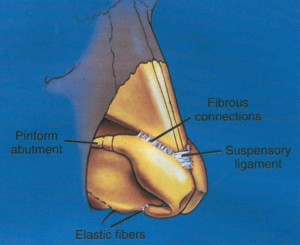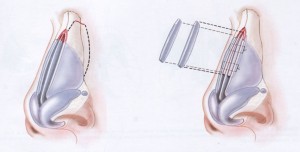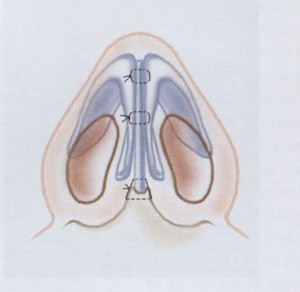Deformities occurring after rhinoplasty result from some factors: inadequate preoperative diagnose, incorrect choice of technique, mistaken execution of surgical maneuvers and unfavorable scarring. Structural and functional deformities may be caused by an aggressive nasal skeleton withdrawal, imperfect maintenance or reconstruction of its support structures. If these structures are modified and there is no attempt of reconstitution, nasal tissue contractile forces may deform the desired postoperative result during the healing process.
Most of the nose’s support mechanism can be distorted interrupted during the rhinoplasty. Any incision made through these mechanisms (picture 1) requires reconstitution for the maintenance of its structural skeleton. The nasal osteocartilaginous integrity must be respected during these procedures. Skin characteristics influence its own contour on the nasal structure. Thick skin might not satisfactorily be molded to the postoperative structure, while thin skin will adjust itself quickly. In the latter, a symmetrical, accurate and steady structure is necessary to prevent possible irregularities visible in the future.
Figure 1 – Support framework of the nose ligaments
Open Structure Rhinoplasty must be the chosen technique because it preserves the osseous and cartilaginous nose skeleton more precisely at direct sight, so the surgeon can see all the nasal structures and its defects. Therefore, this technique allows to adequately evaluate which must be the surgical plan for that specific patient. There is no formula to be followed. Each case must be carried through in accordance with the patient’s anatomy and symptoms. The nasal skeleton must be precisely sculptured and strengthened with attachment points and grafts (cartilage pieces) in order to reconstruct or to preserve the respiratory function as well as the desired aesthetic aspect after a long postoperative period. Race, gender and age are also important in the evaluation. The surgery can be of reduction (removal) in some areas and of augmentation (grafts placing) in others (pictures 2 and 3).
Picture 2 – Detail showing reduction area in the back to improve nasal aesthetic, and then augmentation with spreader-grafts to improve the respiratory function.
Picture 3 – Detail showing a strut graft to structure the nasal tip.
Rhinopasty evolved from a mere reductive procedure to a more efficient approach on the nose. It now emphasizes the repositioning, augmentation and reorganization of the nasal anatomy to create the most natural and functional nose possible. This technique allows having a permanent change in the nasal shape that will not be subject to alterations throughout time or due to scarring.
The closed technique can be performed in some cases, but it is much more difficult to carry the structure rhinoplasty through this approach, what makes it improper for the respiratory function and for the nasal aesthetic in the long term. However, there are great plastic surgeons who obtain excellent results with the internal approach.
The structure rhinoplasty is generally performed with local anesthesia with sedation, being an outpatient procedure. Although the result’s final appearance takes at least 1 year, the basic healing process is relatively quick. Usually, the patient will be able to remove the nasal plaster splint in 1 or 2 weeks and the most visible signs of the surgery disappear in 2 or 3 weeks. It is usually performed with general or local anesthesia with sedation.




